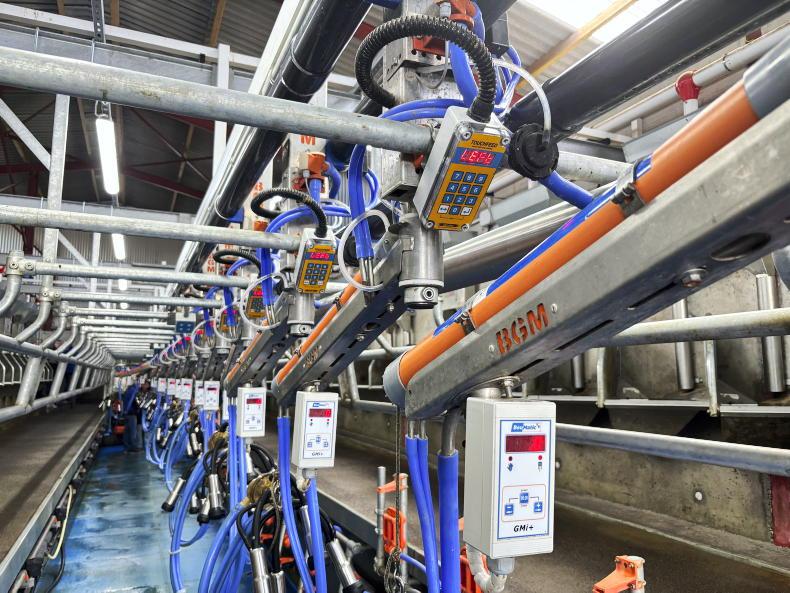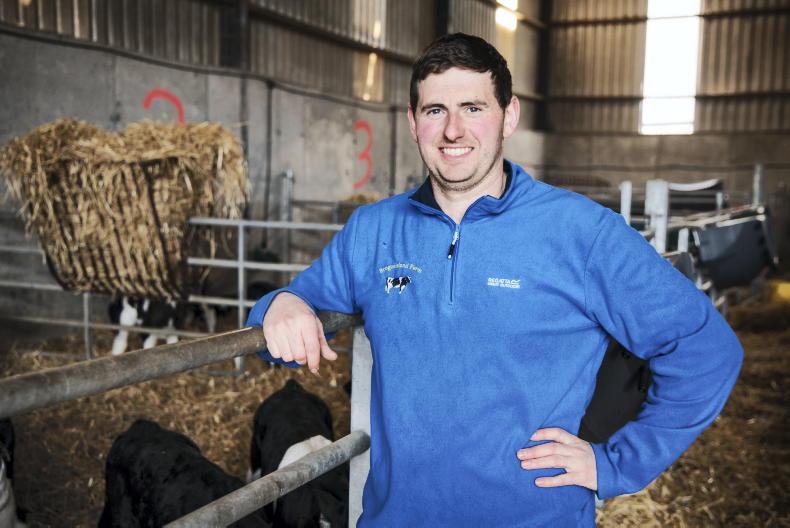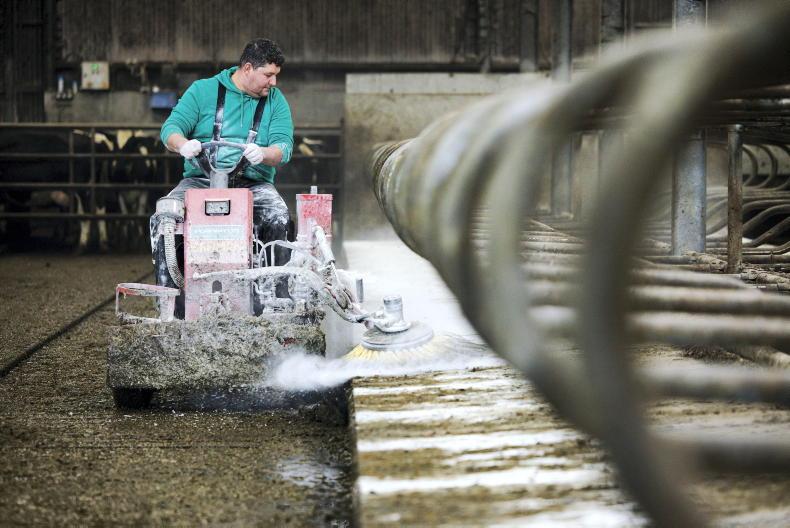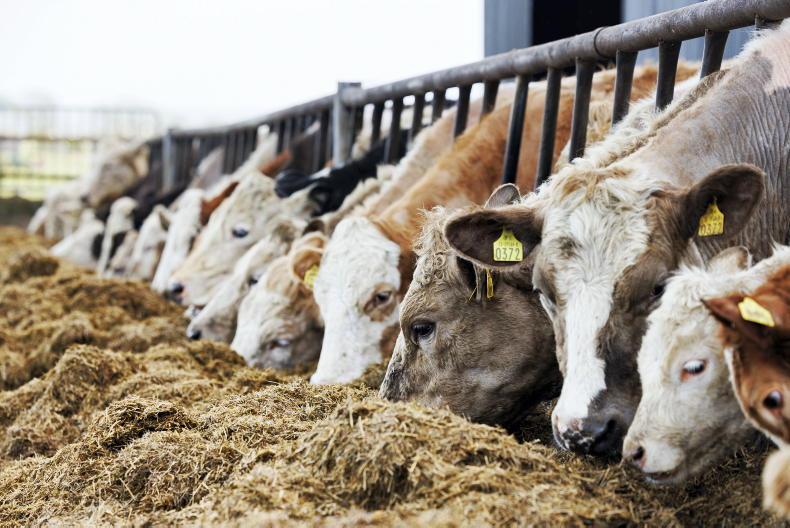Milking facilities are the centre hub on any dairy farm, but these can sometimes be neglected behind other investments.
As the expansion phase of the dairy industry is beginning to plateau, many farms will have outgrown the current milking facilities with milking times getting longer and collecting yards pushed to their limits.
The obvious solution would be to extend the parlour units to reduce rows to between six and eight rows per milking. The more complicated decision to be made, however, is around drafting and handling facilities, and how that can impact milking times and work-life balance.
The Irish Farmers Journal visited the Costigan farm in Johnstown, Co Kilkenny, where Willie and his son Tommy have been milking 240 cows through a 24-unit Deleval milking parlour since 2009.
The pair have recently upgraded facilities on the farm, focusing on improving cow flow, drafting and facilities, while also cutting down on time spent washing up the yard.

Costigans extended the front of the parlour for better cow flow.
Starting where the cows enter for milking, whether cows are coming from paddocks or the cubicle shed, they enter through a gate at the back of the collecting yard.
When building a collecting yard, it is key to have cows entering the back of the yard coming from the side.
Cows will then be facing the parlour and this means they won’t be crossing over a backing gate. U-turns into the collecting yard should be avoided also, if possible.
Capacity
The yard is built for 300 cows at 1.5m2 per cow. The rectangular-shaped yard is easier to construct and also easier to expand in the future. This allows cows to have movement within the yard, which doesn’t upset social order.
At the top of the yard, there is a slatted tank, which the backing gate scrapes into and can be pumped to the cow shed.

The entrance to the collecting yard, with no sharp turns and all cows facing the parlour.
Having no slopes or steps on entrance or exit is key, with as much natural light as possible.
The cows exit the parlour to the left; with cow flow in mind, the front of the parlour was extended to remove any sharp turns, which has sped up the time it takes for cows to exit and has also improved hoof health.
Cow flow
The old handling facilities had cows doing a 90-degree turn and walking through the drafter, where the crush is now.

View of the new handling facilities, where design was kept compact making use of all space available.
Putting the drafter to the other side of the yard has removed the U-turn for cows, which has further helped with cow flow.
Keeping cows moving in as much of a straight line as possible is key for cow flow.
Without breaking the bank, the Costigans have been able to improve this, speed up milking times and make the milking parlour a much more enjoyable place to work.
While the Costigans already had a drafter, a lot of farms do not. Improving milking efficiency comes down to one main area: how often, during milking, does the operator have to stop to put clusters on cows?

The Costigans placed the drafter on slats to reduce time spent washing up after milking.
In the most efficient parlours, the operator won’t leave the pit from the first cluster on until the last cluster is off.
Careful planning and adding simple technologies, such as backing gates and automatic drafters, are some things which can greatly improve efficiency for a relatively low investment cost.
Drafting cows
Some farms will have expanded in recent years from six- or eight-unit milking parlours to 14 to 20 units.
Throughout the busy breeding period, drafting cows in a smaller parlour wouldn’t be as much of a task, as there might only be one cow to separate per row, and the farmer would be waiting for cows to milk out anyway.

Willie and Tommy Costigan with their new drafting and handling facilities in Co Killkenny.
When numbers get higher and there are more cows to be separated, this is where a drafter becomes essential and should be considered in any system from 10 units up.
When planning a drafting system, it is also important to make sure the holding pen is big enough, as it can be used for separating larger numbers at times, such as drying off, scanning, etc.
A slatted tank was dug in the Costigans’ yard where the drafter stands. A channel links this tank to the one in the collecting yard to reduce workload in emptying tanks.
This has also dramatically reduced time at wash-up, as the old drafter chute had to be scraped out every day.
Directly after the drafter, there is a side-by-side crush. There would usually be a chute after the drafter anyway, so the crush has been doubled up as a chute and a crush.
“Having the cows going through the crush every day has a huge benefit when it comes to using the crush. Before, cows might only be in the crush three to four times a year and so would be a bit nervous. Now, cows are used to it and this takes all the work out of loading cows,” Tommy said.

When building a collecting yard, it is key to have cows entering the back of the yard coming from the side.
“The crush can hold a whole row in the parlour, but we only put in 12 at a time now. I find there can be a lot of pressure on the first cow when it’s full. We use the side-by-side crush mostly now.
"Tail clipping, vaccination, AI, scanning and TB-testing is all done through the side-by-side crush. The only time we would use the normal one was if a vet preferred to use it,” he said.
After walking through the crush, there is a footbath directly after where cows can be directed to for regular hoof maintenance. It’s important to note that throughout this, cows never turned and were walking straight.
From a health and safety point of view, it is important to add in as many human exits as possible. This is something which must be incorporated from planning, and they should be located in areas where people are most likely to be.
There also are Censortec collars on all cows. Tommy commented on how this has improved quality of life for the farming family.
They have a full-time staff member on the farm, and there would be periods where neither Willie or Tommy would be at home at milking time.
“I was on holidays for a week during the breeding season last year. I was able to draft out cows, which were ready and waiting for the AI technician in the holding yard, without even having to tell the milker,” said Tommy.
Milking facilities are the centre hub on any dairy farm, but these can sometimes be neglected behind other investments.
As the expansion phase of the dairy industry is beginning to plateau, many farms will have outgrown the current milking facilities with milking times getting longer and collecting yards pushed to their limits.
The obvious solution would be to extend the parlour units to reduce rows to between six and eight rows per milking. The more complicated decision to be made, however, is around drafting and handling facilities, and how that can impact milking times and work-life balance.
The Irish Farmers Journal visited the Costigan farm in Johnstown, Co Kilkenny, where Willie and his son Tommy have been milking 240 cows through a 24-unit Deleval milking parlour since 2009.
The pair have recently upgraded facilities on the farm, focusing on improving cow flow, drafting and facilities, while also cutting down on time spent washing up the yard.

Costigans extended the front of the parlour for better cow flow.
Starting where the cows enter for milking, whether cows are coming from paddocks or the cubicle shed, they enter through a gate at the back of the collecting yard.
When building a collecting yard, it is key to have cows entering the back of the yard coming from the side.
Cows will then be facing the parlour and this means they won’t be crossing over a backing gate. U-turns into the collecting yard should be avoided also, if possible.
Capacity
The yard is built for 300 cows at 1.5m2 per cow. The rectangular-shaped yard is easier to construct and also easier to expand in the future. This allows cows to have movement within the yard, which doesn’t upset social order.
At the top of the yard, there is a slatted tank, which the backing gate scrapes into and can be pumped to the cow shed.

The entrance to the collecting yard, with no sharp turns and all cows facing the parlour.
Having no slopes or steps on entrance or exit is key, with as much natural light as possible.
The cows exit the parlour to the left; with cow flow in mind, the front of the parlour was extended to remove any sharp turns, which has sped up the time it takes for cows to exit and has also improved hoof health.
Cow flow
The old handling facilities had cows doing a 90-degree turn and walking through the drafter, where the crush is now.

View of the new handling facilities, where design was kept compact making use of all space available.
Putting the drafter to the other side of the yard has removed the U-turn for cows, which has further helped with cow flow.
Keeping cows moving in as much of a straight line as possible is key for cow flow.
Without breaking the bank, the Costigans have been able to improve this, speed up milking times and make the milking parlour a much more enjoyable place to work.
While the Costigans already had a drafter, a lot of farms do not. Improving milking efficiency comes down to one main area: how often, during milking, does the operator have to stop to put clusters on cows?

The Costigans placed the drafter on slats to reduce time spent washing up after milking.
In the most efficient parlours, the operator won’t leave the pit from the first cluster on until the last cluster is off.
Careful planning and adding simple technologies, such as backing gates and automatic drafters, are some things which can greatly improve efficiency for a relatively low investment cost.
Drafting cows
Some farms will have expanded in recent years from six- or eight-unit milking parlours to 14 to 20 units.
Throughout the busy breeding period, drafting cows in a smaller parlour wouldn’t be as much of a task, as there might only be one cow to separate per row, and the farmer would be waiting for cows to milk out anyway.

Willie and Tommy Costigan with their new drafting and handling facilities in Co Killkenny.
When numbers get higher and there are more cows to be separated, this is where a drafter becomes essential and should be considered in any system from 10 units up.
When planning a drafting system, it is also important to make sure the holding pen is big enough, as it can be used for separating larger numbers at times, such as drying off, scanning, etc.
A slatted tank was dug in the Costigans’ yard where the drafter stands. A channel links this tank to the one in the collecting yard to reduce workload in emptying tanks.
This has also dramatically reduced time at wash-up, as the old drafter chute had to be scraped out every day.
Directly after the drafter, there is a side-by-side crush. There would usually be a chute after the drafter anyway, so the crush has been doubled up as a chute and a crush.
“Having the cows going through the crush every day has a huge benefit when it comes to using the crush. Before, cows might only be in the crush three to four times a year and so would be a bit nervous. Now, cows are used to it and this takes all the work out of loading cows,” Tommy said.

When building a collecting yard, it is key to have cows entering the back of the yard coming from the side.
“The crush can hold a whole row in the parlour, but we only put in 12 at a time now. I find there can be a lot of pressure on the first cow when it’s full. We use the side-by-side crush mostly now.
"Tail clipping, vaccination, AI, scanning and TB-testing is all done through the side-by-side crush. The only time we would use the normal one was if a vet preferred to use it,” he said.
After walking through the crush, there is a footbath directly after where cows can be directed to for regular hoof maintenance. It’s important to note that throughout this, cows never turned and were walking straight.
From a health and safety point of view, it is important to add in as many human exits as possible. This is something which must be incorporated from planning, and they should be located in areas where people are most likely to be.
There also are Censortec collars on all cows. Tommy commented on how this has improved quality of life for the farming family.
They have a full-time staff member on the farm, and there would be periods where neither Willie or Tommy would be at home at milking time.
“I was on holidays for a week during the breeding season last year. I was able to draft out cows, which were ready and waiting for the AI technician in the holding yard, without even having to tell the milker,” said Tommy.















SHARING OPTIONS